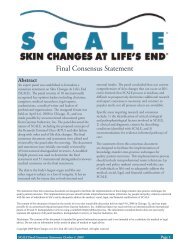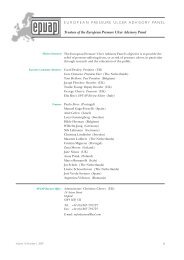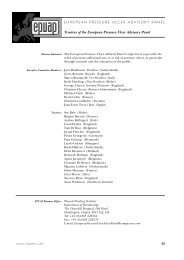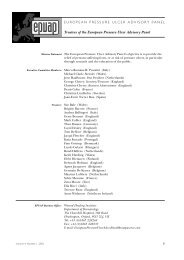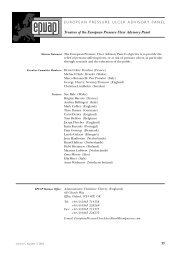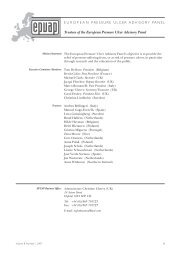Review 6.2 - European Pressure Ulcer Advisory Panel
Review 6.2 - European Pressure Ulcer Advisory Panel
Review 6.2 - European Pressure Ulcer Advisory Panel
You also want an ePaper? Increase the reach of your titles
YUMPU automatically turns print PDFs into web optimized ePapers that Google loves.
EUROPEAN PRESSURE ULCER ADVISORY PANEL<br />
risk assessment scales. An analysis of published studies on<br />
risk assessment scales reveals that although some patients<br />
got preventive measures and others did not, this was not<br />
taken into account. Consequently, generalisation of those<br />
results is not possible. Rethinking risk assessment scales and<br />
research on pressure ulcer incidence using risk assessment<br />
scales in combination with a preventive protocol is needed.<br />
PRESSURE ULCERS 6 (THERAPY DEVICES)<br />
MODE OF ACTION<br />
D. Berlowitz (US)<br />
The healing of a pressure ulcer is a complex process that<br />
frequently requires months of Intensive therapy. Reducing<br />
the time required to heal a pressure ulcer, and the cost of<br />
care, are important goals. A wide variety of adjunctive interventions<br />
are available that may promote the healing of<br />
pressure ulcers. These therapy devices include electrical<br />
stimulation, negative pressure wound therapy, noncontact<br />
normothermic wound therapy, ultrasound, ultraviolet radiation,<br />
and hyperbaric oxygen. Each of these therapy devices<br />
has been hypothesized to have a unique mode of action<br />
that will be reviewed. Evidence supporting the efficacy<br />
of these interventions will also be considered.<br />
PRESSURE ULCERS 5 (SURGICAL REPAIR)<br />
SURGICAL TREATMENT OF PRESSURE SORES<br />
C. Kauer (FR)<br />
For the plastic surgeon, the pressure treatment needs two<br />
actions: resection and reconstruction. We exclude also all<br />
pressure sores where the medical treatment with adapted<br />
dressing and nursing allows a directed healing The surgical<br />
treatment concerns the pressure sores with a minimal<br />
height of 5cm for the diameter, located in area with bone<br />
protrusion, essentially pressure sores of the pelvic arch. The<br />
surgical treatment requires three stages: 1) preparation<br />
stage with information of the patient for the surgical imperatives;<br />
2) surgery stage with the choice of a secure technique<br />
which needs to preserve the maximum of skin and<br />
muscle, useful in case of recurrence; 3) post-operative stage<br />
requiring cooperation and responsibility of the patient. The<br />
techniques are multiple from the most simple such as local<br />
plasty, to the most sophisticated such as distal flaps cutaneous,<br />
muscular, or mainly musculo-cutaneous. An imperative<br />
condition: thick tissue cover, well vascularised, occasionally<br />
sensitive, overall bringing a durable mattress on the<br />
bone protrusion area. The indications are directed by two<br />
factors: the patient and the pressure sore. Four elements<br />
linked to the patient, supervise the choice of the ideal indication:<br />
cooperation; autonomy; nutritional balance; continence<br />
or controlled incontinence. Depending on the location<br />
of the pressure sore, four rules guide the choice of the<br />
technique used: one operative stage, direct closure of the<br />
donor site, respect of the cutaneous and muscular capital<br />
of each possible location of the pressure sore, most reduce<br />
delay of hospitalisation.<br />
Conclusion: It exists an ethic of the surgery treatment of pressure<br />
sores: the surgeon has a commitment by the choice of<br />
adapted techniques and an obligation of result with the target<br />
to give function the most rapidly possible to the patient<br />
with pressure sores.<br />
Key-words: Pelvics, Musculo-cutaneous flaps, Autonomy.<br />
PRESSURE ULCERS 5 (SURGICAL REPAIR)<br />
PREVENTION OF RECURRENCE AFTER<br />
SURGERY<br />
M.J. Lubbers (NL)<br />
A patient who needs surgical repair for a pressure ulcer, is<br />
always at risk of recurrence after surgery. In general, the<br />
condition of this patient is impaired. The circulation and<br />
sensibility at the top of the surgical repair is less than normal.<br />
This patient always needs quality pressure ulcer after<br />
care. The problem is the fragmented health care system.<br />
Prevention of pressure ulcers needs a holistic approach. To<br />
improve the level of care in one place and to disregard the<br />
others is useless. Most use of high-tech devices is in specialist<br />
centres or IOU settings. In the after care after surgery,<br />
often less advanced beds, mattresses and cushions are used.<br />
Therefore, the recurrence rate is high. Only with a total<br />
holistic approach is this kind of surgery effective.<br />
PRESSURE ULCERS 6 (THERAPY DEVICES)<br />
DEVELOPING TRIALS<br />
J. Nixon (UK)<br />
Clinical trials which aim to compare the effectiveness of pressure<br />
ulcer prevention and treatment therapy devices present<br />
a number of challenges relating to both trial design and trial<br />
conduct, such as the definition and measurement of<br />
endpoints and complex patient populations and care environments<br />
which impact upon trial participation, outcome<br />
assessment and compliance. Both problems and solutions<br />
will be discussed and presented including: a brief overview<br />
of: superiority, equivalence, non-inferiority and sequential<br />
trial designs; the importance of quality components such as<br />
an a priori sample size, allocation concealment, intentionto-treat<br />
analyses and interpretation of results in minimizing<br />
bias and; the use of Good Clinical Practice guidelines and<br />
the CONSORT statement as quality frameworks for the planning<br />
and conduct of clinical trials in the field.<br />
PRESSURE ULCERS 2 (EDUCATION AND<br />
GUIDELINES) IMPROVE GUIDELINES<br />
PRESSURE ULCER CARE<br />
R.J.H. Halfens (NL)<br />
Prevalence studies typically indicate that many patients have<br />
pressure ulcers while in health care institutions. Perhaps<br />
this is because pressure ulcer prevention and treatment is<br />
not optimal For instance, in the Netherlands almost 40%<br />
of pressure ulcers were not treated according to the recommendations<br />
within the national guidelines, while only 20%<br />
of patients received appropriate preventive measures<br />
(Bours, Halfens and Wansink, 2003). So why aren’t guideline<br />
recommendations implemented There are several reasons<br />
why the production of a guideline is not always followed<br />
by changes in patient outcome. First of all, providing<br />
52<br />
Volume 6, Number 2, 2004



